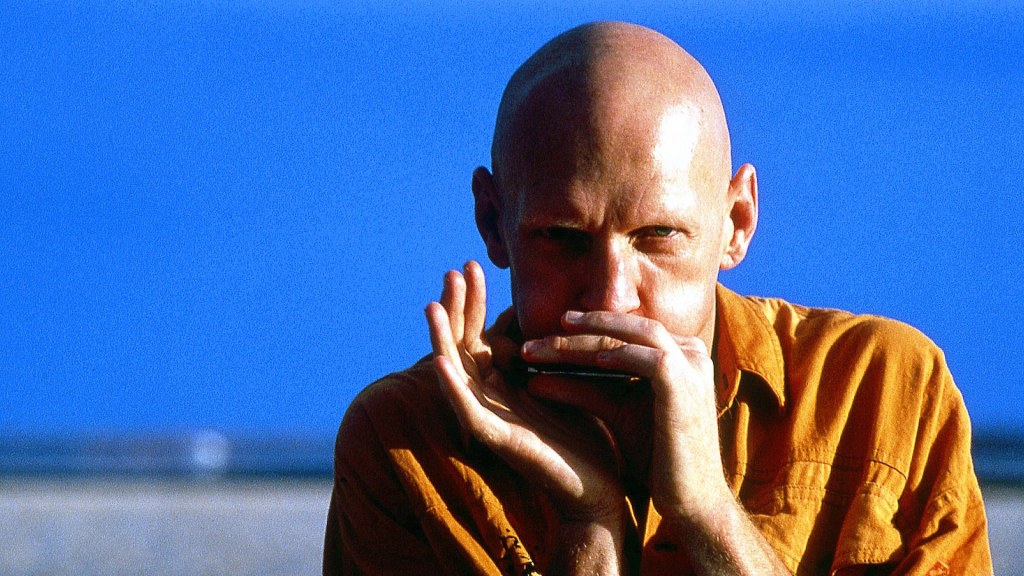Midnight Oil have always been a hard band to categorise. Since forming in Sydney in the mid-1970s, they’ve often been lumped under the “pub-rock” banner. But this tag doesn’t account for the band’s left-wing politics and anti-racist messaging, which are essential elements of the Midnight Oil DNA.
The band’s origins in Sydney’s thriving mid-‘70s pub scene did play a central role in 2014’s The Making of Midnight Oil exhibition, which illustrated that the Oils’ ascent to arena-filling rock stardom was paved by hundreds of hours of rock’n’roll dirty work. It was time well spent, too – from their second album, 1979’s Head Injuries, onwards, Midnight Oil were as good as anyone at combining post-punk’s off-centre experimentalism with radio-ready hooks and ideological intent.
It’s tempting to describe a lot of Midnight Oil’s songwriting as ahead of its time, particularly where it concerns climate destruction and advocating for justice for this land’s first peoples. But Garrett and his songwriting pals, Rob Hirst and Jim Moginie, weren’t consulting a crystal ball for inspiration; they were just tuned in to what was happening around them.
The fact Midnight Oil devoted significant chunks of recorded time to opposing nuclear arms and corporate desecration of the natural world, while also highlighting Indigenous dispossession, reveals how long these issues have been in the public consciousness. But as the Oils would be eager to emphasise, they’re a rock band first and foremost and not some political communications enterprise. As such, their catalogue remains a great source of entertainment and uplifting power.
Let’s get to know 10 Midnight Oil essentials.
1. ‘Back On the Borderline’, Head Injuries (1979)
Midnight Oil formed in the early 1970s as Farm. They went through a variety of lineup changes while completing university degrees and finding their footing on the Northern Beaches music scene. By 1976, they’d decided to take the band seriously. They ditched Farm in favour of Midnight Oil and together with manager Gary Morris formed the label Powderworks.
The label issued their self-titled debut album in 1978, but it wasn’t until the following year’s Head Injuries that the seeds of the band’s greatness would begin to flower. The album’s standout track, ‘Back on the Borderline’, remains a live staple to this day. It’s essentially a new wave rock song akin to Elvis Costello or The B-52’s, but the Oils already had a thing for arena rock theatrics. They’re on display here courtesy of drummer Rob Hirst’s trademark percussive athleticism.
Garrett mightn’t be the most technically gifted vocalist, but he was always a charismatic presence out front, which is beautifully amplified in the ‘Back on the Borderline’ recording.
2. ‘Only the Strong’, 10, 9, 8, 7, 6, 5, 4, 3, 2, 1 (1982)
Songwriting duties were split between Hirst, Garrett and guitarist Moginie throughout the band’s career, with Hirst and Moginie being the more prodigious of the trio. Political themes showed up in the writing of all three, but it’s not all they wrote about.
‘Only the Strong’, track two from 1982’s 10-1, is told from the perspective of someone who feels powerless in a world of strongmen. Whether the narrator is a prisoner or a lone, frustrated citizen is unclear, but the central point sticks – so much is out of our hands to the point of being paralysing.
10-1 was the first in a quadrilogy of front-to-back classic albums from the Oils and ‘Only the Strong’ finds the band firing on all cylinders. It’s a dynamic and over-the-top post-punk song that makes bands like PiL sound conservative by contrast.
3. ‘US Forces’, 10, 9, 8, 7, 6, 5, 4, 3, 2, 1 (1982)
Compared to the frenzy of ‘Only the Strong’, ‘US Forces’ is one of the more circumspect tracks on 10-1. It’s built around a call-and-response exchange between an acoustic guitar riff and Garrett’s vocals. The lyrics zero in on the US military’s tendency to meddle in the affairs of any nation whose leader’s principles are out of step with their own.
When Garrett was running for a seat in federal parliament in 2004, then-Foreign Minister Alexander Downer called attention to ‘US Forces’, claiming it could jeopardise US-Australian relations. It’s a grand compliment to Midnight Oil, who were always committed to rattling the cage of the unscrupulous establishment. It’s worth noting that ‘US Forces’ is damn catchy, too.
4. ‘When the Generals Talk’, Red Sails in the Sunset (1984)
‘When the Generals Talk’ kicks off Red Sails in the Sunset, which could be the Oils’ most consistent set of songs. ‘Generals’ is one of the record’s more outwardly new wave-inspired tracks, giving prominent airtime to some space-age sample pads. The targets of its lyrics are down here on earth, however, with Hirst and Garrett trading lines directed at populist politicians who’ll say whatever it takes to get elected. Sound familiar?
The majority of tracks from Red Sails featured in the band’s famous Oils on the Water performance, which took place on Sydney’s Cockatoo Island in January 1985. Garrett adds a new verse to the live rendition, calling out governments who don’t care about “young Australians,” “nuclear weapons,” “resources and the environment,” and “anything else other than their exclusive, cynical chase for power.” Yep, sounds familiar.
5. ‘Kosciusko’, Red Sails in the Sunset (1984)
While I’d refrain from giving them too much credit, it’s fair to say Midnight Oil’s persistent focus on Indigenous dispossession helped bring these matters into the wider public consciousness. Their songs often spoke on behalf of First Nations peoples, which could easily be seen as problematic, but they deserve credit for never glossing over the tragedies inflicted by white Australia.
These songs worked better when presented as commentaries, such as with ‘Kosciusko’, which looks at how Europeans drove Indigenous communities away from country and claimed ownership of sacred sites without any consultation. It’s a sad song, but one that also could strike electricity through a crowded pub venue.
6. ‘Hercules’, Species Deceases (1985)
‘Hercules’ shows up on the 1985 EP, Species Deceases, which is further evidence of the sizzling hot steak Midnight Oil had become by the mid-1980s. The EP went to number one in Australia, but it’s not as commercially sculpted as the subsequent LP, Diesel and Dust.
‘Hercules’ is a leaner, more live-oriented production, which sounds not unlike The Replacements while also revealing the Oils’ anthemic flair. The lyrics highlight the personal losses that would result from nuclear warfare – it’d be impossible to keep enjoying life if the US and Russia started dropping bombs on each other.
7. ‘Beds Are Burning’, Diesel and Dust (1987)
‘Beds Are Burning’ frequently ranks high in lists of the greatest Australian songs of all time, but it was also a worldwide hit – it reached the top ten in the UK and France and made it into the US Billboard top 20. On the one hand, it’s a very Australian song. Garrett’s lyrics were written following a tour through a number of remote Indigenous communities in 1986 and he makes an unambiguous call for white Australians to “pay the rent.” But this should also sound familiar to anyone living in a former (or current) Imperial power.
‘Beds Are Burning’ took on newfound potency when the band performed it at the Sydney 2000 closing ceremony dressed in custom black outfits with the word “Sorry” emblazoned on them. It was a protest against Prime Minister John Howard’s refusal to apologise to Australia’s Indigenous peoples.
8. ‘Blue Sky Mine’, Blue Sky Mining (1990)
Midnight Oil had a knack, perhaps unmatched among bands in their field, for turning the most unlikely subjects into catchy rock anthems. ‘Blue Sky Mine’, the almost-title track from the band’s seventh album, is about the workers at the CSR mines in Wittenoom, Western Australian who suffered from life-altering blue asbestos poisoning in the ‘50s and ‘60s.
It’s the sort of subject that’d make most songwriters run a mile, but for the Oils – who were always interested in exposing corporate negligence, environmental destruction in the name of profit, and the darker details of Australian history – it was ripe fodder for their first single of the 1990s, which might be the strongest pop song they ever released.
9. ‘Forgotten Years’, Blue Sky Mining (1990)
Pop songs were in rich supply on Blue Sky Mining, which has made it one of the band’s most enduring LPs. ‘Forgotten Years’ pulls back from the patent commercial designs of Diesel and Dust to present a highly melodic guitar pop number that features an absolute belter of a chorus. Again, beneath the shimmering veneer there’s a darker story to tell, with Rob Hirst’s lyrics magnifying the indelible horrors of war.
10. ‘Truganini’, Earth and Sun and Moon (1992)
‘Truganini’ takes its name from a 19th-century woman who was believed to be one of the last direct descendants of the Indigenous people of modern-day Tasmania. The song isn’t a retelling of Truganini’s story, but the band uses her legacy as an example of how much devastation white Australia has caused Indigenous people.
The song makes a broader statement about how brutal this land can be and how poorly suited Europeans are to its climate. We’d have been better off leaving it alone, Garrett suggests, so that people like Truganini and Albert Namatjira could’ve lived freely.
–












